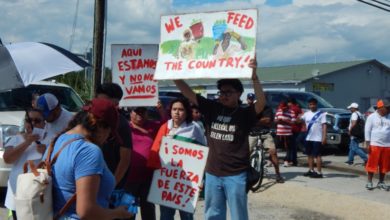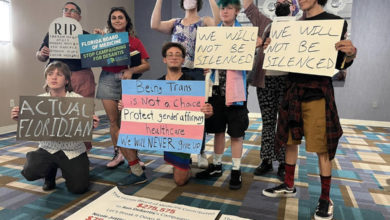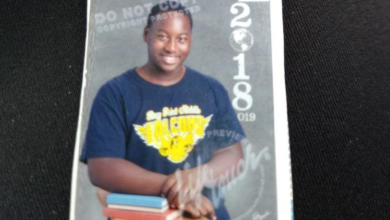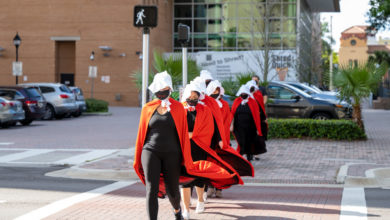On June 14, the racist Miami police shot and killed Husein Shehada, a 29-year-old Palestinian-American, on Washington Avenue and 11th Street, in a popular section of Miami’s South Beach. Husein was in Miami vacationing with his brother, Samer, and their girlfriends.
 Community members held a press conference following the police killing of Palestinian-American youth. |
Sketchy details provided by police through initial press reports have been increasingly scrutinized over the past several days because of the public outcries of Shehada’s family, the American-Arab Anti-Discrimination Committee and other community organizations.
The MBPD said that the officers were responding to numerous 911 calls that a man was walking down Washington Avenue with a gun. Several officers in patrol cars stopped the two brothers because “they fit the description of the suspects.” A few seconds later, Husein was on the sidewalk dying at his brother’s feet.
The MBPD confiscated and tried to suppress the release of a surveillance video showing the shooting. Samer’s girlfriend, Karlia Karpel, told local media that the officers asked if the dying Husein was “Arabic” or spoke “Arabic.”
Samer was then arrested for assaulting his girlfriend in an incident the police says happened before the shooting, a charge that Karpel adamantly denies. No scars or bruises are anywhere on her body. This was part of an attempt to intimidate the family and obscure the real details of the police killing.
Police ‘account’ quickly falls apart
In recent days, the bizarre story that police provided to justify the deadly force used on Shehada has been shown to be a coverup.
On June 18, just four days after murdering Husein, Officer Adam Tavss was cleared of any wrongdoing, following a “full investigation” by the Miami Dade district attorney’s office and the police department. Once back on duty, Tavss was almost immediately involved in another deadly shooting.
Samer Shehada, who buried his brother only a day before the second killing, questioned the rationale of the MBPD: “It makes me feel terrible, it’s like they didn’t take my brother’s killing seriously enough to keep him [Tavss] off the street to do a proper investigation.”
John Rivera, Miami Dade Police Benevolent Association president, arrogantly told the press that there was enough information at the onset of the first shooting that it would not have been alarming to anyone to have the officer on the streets. The racist murder of an unarmed man did not cause any alarm within the same MBPD that was trying to cover it up.
The police department that was slow to initially release any information regarding the investigation of Shehada’s death was quick to go on a public relations offensive after the second shooting.
A June 19 propaganda piece published in the Miami Herald ran an “account of events” by what they called “a source with knowledge of the investigation.”
The story centered on the statements of a bouncer who told police that he called 911 when he saw the two brothers walking down Washington Avenue, believing that they were armed. He recognized Samer from an earlier altercation involving what the account says where “two unknown individuals” who intervened when Samer allegedly was beating his girlfriend earlier in the night.
A day later, the news reported that the bouncer, the only witness corroborating the MBPD’s story, has strong connections to the police department. He has an uncle who works in the MBPD and has himself applied for a job with the department. He also worked with the Broward sheriff’s department, also known for racist police brutality.
Police departments often defame the character and family of the victim in an attempt to justify racist police killings. The police account of events—corroborated by one unreliable witness—is part of an attempt to do this to Shehada and his family.
Community says ‘Jail Killer Cops’
On July 19, community organizations, including the South Florida Palestine Solidarity Network, the ANSWER Coalition (Act Now to Stop War and End Racism) and Jewish Voice for Peace, held an emergency demonstration and press conference in front of the MBPD headquarters—across the street from where Shehada was murdered. Most of the local media, both Spanish and English language, attended the conference.
Organizers demanded that the killer cop be jailed, that all information regarding the death of Shehada, including the surveillance video, be released and that an independent investigation, including community members, take place. Participants then spent several hours marching the streets of South Beach with placards and leaflets informing community members of the racist police murder and coverup. Many onlookers expressed signs of solidarity and others joined the impromptu march.
A few hours after the press conference, the surveillance footage was released to local media. The police claimed the video showed the two men “looking menacing,” and Husein reaching for what they thought was a weapon. What it shows is the cold-blooded murder of an Arab man, and the extent that the MBPD would lie to cover it up and protect one of their own.
Husein’s death is another brutal example of how an epidemic of racist police killings is plaguing communities of color throughout the United States. Violent police harassment is a routine part of life for Black, Latino, Arab and other youth of color because of the countrywide institutionalization of racial profiling, stop and frisk, anti-gang injunctions, racist checkpoints—and, of course, outright murder.
In the coming weeks, community organizations will continue to mobilize and build a campaign so that justice for the Shehada family can be realized.
To watch the video of the surveillance footage released during the press conference, click here.






